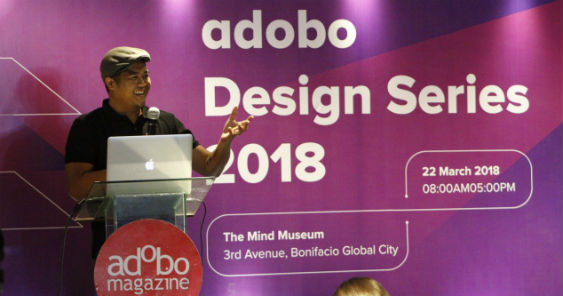Visual Research of Philippine Imagery by Team Manila’s Jowee Alviar
By Nicai de Guzman
Even before co-founding Team Manila, a graphic design studio that also produces lifestyle merchandise that exude Pinoy pride, Jowee Alviar has always been interested in history.
When Alviar was studying at CalArts, they had a class on History of Graphic Design. “That class made a mark with me. What’s the history of graphic design here in the Philippines? That led to my investigation,” Alviar said.
Alviar said that the current Philippine graphic design styles are a mix of different things – American media, Spanish influence, love of Japanese culture, to name a few. But what about purely Filipino designs?
“What are the images in our history that came from the Philippines or talks about the Philippines? We need to know our history so that led to this investigation and research,” Alviar said.
He presented his findings or visual research of Philippine imagery during the adobo Design Series 2018 on March 22 at The Mind Museum.
From nature to national heroes
Aside from the popular Pintados, an obvious example of art during Philippine pre-colonial times, the Baybayin is also something one should look at, according to Alviar. Baybayin, which was inspired by the Sanskrit of Eastern form of lettering, could also tell us a lot about Philippine’s earliest designs.
For example, the symbols found on the copper plate of Laguna would show us that there are patterns related to nature. These patterns had symbols of the sun, spirit, animals like bayawak, snakes, frogs. When the Spaniards came and converted Filipinos to Christianity, the reoccurring patterns in designs had crosses, diamonds, and geometric shapes.
“The Bontoc preserved their culture and icons because the Spanish missionaries didn’t reach that level,” Alviar said, pertaining to cultural patterns that still exist in contemporary Bontoc designs.
At the turn of the 19th century, packaging of products by companies are also telling of the country’s situation. Cigarette packaging such as La Campana, Balita, Tatlong Diwata, and Kayamanan used illustrations of nature and images of national heroes such as Jose Rizal.
“These are the things we want to research more on, what are the other labels that time? So it’s a mix of typography, patterns. The style is European but the content is Filipino,” he said.
During the World Exposition Fair at St. Louis in 1904, Americans brought Filipino natives together with native huts. Alviar showed how the promotional brochures looked like for the fair, depicting Filipinos to be savages.
Back in the Philippines, the Manila Carnival, a precursor to the Bb. Pilipinas, also had some interesting promotional materials. Each poster would promote a province which would even have their own pavilion, queen, and elements of what their province is known for.
Aside from the Manila Carnival, theaters and vaudevilles were a form of entertainment in Old Manila. These theaters, such as the Manila Grand Opera House, would come out with regular posters with loud, crazy typography and layouts.
Advertisements and street art
Alviar showed the covers of products like Katialis and match boxes which depicted life in the provinces. The boxes had illustrations of carabaos and farmers. The same is true for tobacco print ads, which often portray Filipinos in a cultural setting. For example, a town celebrating a fiesta and people dancing tinikling.
There was a surge of materials about travel and tourism in the ‘20s, with the enhancements in air and sea travel. Most of these brochures show illustrations of Philippine landmarks. Print advertisement of hotels located in the Philippines also promote various Philippine sceneries.
“This is part of our continuous creation of visuals about the Philippines,” Alviar said about these.
When looking at these promotional materials and product packaging, Alviar said that they had some things in common.
“We noticed a certain typeface or look that was consistent that time. When you say Philippines, especially with Philippine culture materials, this Sulu-like [font] with shapes of Sarimanok [are some of the things] we see in different materials,” he said.
After the war, graphic illustrators had a lot of options for employment. From drawing advertising materials, they can also illustrate for magazine of comics. In fact, some of our National Artists such as Fernando Amorsolo started out as illustrators for magazines like Liwayway, Alviar said.
On the other hand, Malang, another esteemed artist, started out as an illustrator who depicted the streets of Manila. Alviar pointed out that the layering of the city is evident in his style.
The streets of Manila is another overlooked venue to study Philippine art, according to Alviar. The dying art of hand drawn movie poster billboards, signages of tarot card readings in front of Quiapo, and shirts with inscriptions of anting antings are just some or the urban art that will soon be part of the country’s narrative.
“So where do we go from here? What we have now so we can create our future,” Alviar said.
“Hopefully we turn this to something we can pass on to our students. Hopefully there will be more materials talking about the rich history of graphic designs.”








